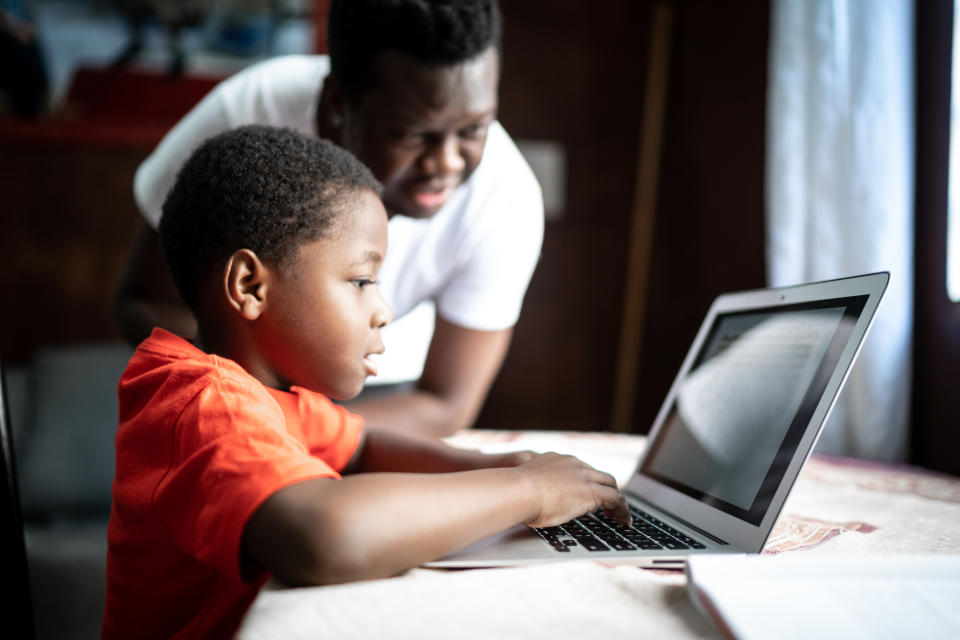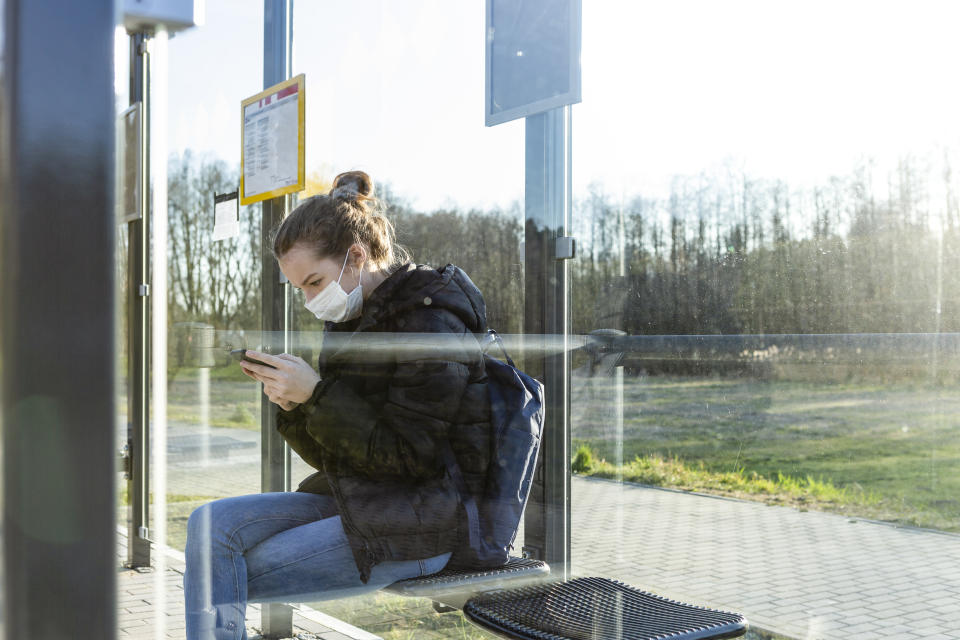How remote learning is revealing a digital divide: 'Not all students have equitable access'

With many students expected to do online learning at home this fall, the pandemic is amplifying the existing digital divide between families who have reliable internet access and devices, such as computers, and those who do not.
It was something exemplified just this week by a heartbreaking Instagram post that went viral, showing two young girls, their faces obscured, sitting on the ground outside a Taco Bell in Salinas, Calif., where they were trying to connect to Wi-Fi in order to log on to remote classes. “Every student from preschool through college should have free access to reliable WiFi especially now,” wrote the woman behind the post, whose mother had shared the photo with her. “What can we do as a community to pull together for students who need something as simple as WiFi in order to succeed?”
Though an update on the post noted that the school district, after identifying the girls in the photo, had provided them with free hotspots, not all kids will be as lucky — and even if they are, such hotspots can be shaky at best.
It’s a huge problem, as, according to a late June 2020 report by Common Sense Media, in partnership with Boston Consulting Group, 50 million K-12 public school students are learning remotely at home because of school closures. Of those, up to 16 million don’t have either adequate internet or devices to effectively do at-home distance learning, while 9 million lack access to both. The report states that this is putting students at a risk of “significant learning loss.”
“COVID-19 has put a spotlight on a hard truth that our members across the country already knew: Not all students have equitable access to the educators, resources and tools they need, including access to technology,” Elic Senter, manager of education, policy and practice at the National Education Association, tells Yahoo Life.
Mark Warschauer, professor of education and director of the Digital Learning Lab at the University of California, Irvine, tells Yahoo Life that online learning works well for “highly motivated” children “with strong autonomous learning and technical skills, and a good technology setup at school. It doesn’t work well for those who lack it.”
Not surprisingly, he adds, “emergency remote learning … has been extremely difficult for children who lack digital devices, stable internet access, digital skills or a safe, quiet environment at home to carry out their work. These kids are falling further and further behind.”
Certain communities hit harder by lack of internet
Low-income households and Black, Latinx and Native American students in particular are less likely to have the essential technology needed for at-home online learning. According to the Southern Education Foundation, data shows that “nearly 20 percent of African-American children ages 3-18 and 21 percent of families earning less than $40,000 per year have no access to the internet at home.”
As the nonprofit public policy organization the Brookings Institution put it: “As neighborhood poverty rises, the broadband adoption rate falls precipitously.”
“When the pandemic shut the U.S. down, students living in historically marginalized communities — where challenges have been exacerbated by generations of systemic racism, classism and inadequate funding of their schools — faced the biggest blow,” says Senter. “Far too many students don’t have the technology and internet access they need to continue learning at home. One in five low-income students have no online access at home.”
This is an even bigger issue for students who are homeless, notes Senter. “Twelve million K-12 students were already in the digital gap before the coronavirus hit,” he says. “Imagine their plight now.”
For low-income families who do have internet access, Warschauer says, many rely on a single mobile data plan. “You can imagine that that would make reliable access to course materials and communications very challenging,” he says.

Senter explains that it’s the lack of broadband internet — not just access to Wi-Fi — that’s the issue. “Wi-Fi is simply how you access the internet connection; many students don’t even have access to the internet, and where they do, the access is spotty,” he says. “That said, lack of access to Wi-Fi — be it through spotty broadband internet service or through hotspots designed to use cellphone towers that also have spotty service — is a major challenge for students working to learn remotely. If students lack sufficient Wi-Fi, they’re prone to having to spend more time figuring out connectivity issues and loading class materials than they are learning and interacting with their educators and peers.”
Students in rural areas with no broadband internet are “the most vulnerable” when it comes to lacking internet access, says Senter. “Thirty-seven percent of rural Americans do not have access to broadband internet service, compared to 25 percent of urban Americans and 21 percent of suburban Americans. While only 10 percent of white Americans lack broadband access, 23 percent of Latinx and 25 percent of Black Americans do not have this access. Those on rural tribal lands are also disproportionately impacted, with seven in 10 residents lacking access to high-capacity broadband.”
So what can be done to help these students?
To really close the internet gap, experts and organizations say more funding is needed. According to the Common Sense Media report, “the cost of closing the digital divide for students is at least $6 billion and as much as $11 billion in the first 12 months, and it would cost an additional $1 billion to close the divide for teachers.” (As many as 400,000 teachers in the U.S. can’t teach because they lack internet access, according to the report.)
Adds Senter: “The most important thing that can be done to improve internet access to students learning at home is to pass more E-Rate funding in Congress. E-Rate has provided nearly $4 billion in annual discounts to ensure schools and libraries have access to broadband and Wi-Fi, and more funding is needed to ensure this extends to students at their homes. Now more than ever, internet should be seen as a public utility. The House version of the HEROES Act included an additional $2 billion in E-Rate funding, while the Senate’s version included $4 billion. This funding is necessary to provide adequate Wi-Fi hotspots, connected devices and mobile wireless service to help our students most in need.”
In the meantime, several internet providers, including T-Mobile, Verizon and AT&T, are offering internet for free, temporarily or at a reduced cost for students and low-income families. In addition, the Federal Communications Commission’s Lifeline program offers discounted broadband internet access and phone services to qualifying low-income families.
“The first option for these schools and districts is to make all efforts to ensure these students have connected devices or Wi-Fi hotspots, either through what is already available or through new purchases,” suggests Senter. “Concerted efforts need to be made in this regard to ensure the students who already lack this access do not fall further behind their peers simply because of where they live.”
Although not necessarily ideal, especially for younger students, many areas throughout the country offer free public Wi-Fi hotspots where students can get internet access in a pinch. Although most libraries and coffee shops are closed due to the pandemic, their routers may still be on and their Wi-Fi accessible from outside the building. In addition, some colleges offer free Wi-Fi in their parking lots. (Just be sure to avoid sharing any personal and financial information when using public Wi-Fi, warns the U.S. Federal Trade Commission.)
Changing how remote learning is taught, such as providing printed materials, can also help students with limited access to the internet. “The best approach is to create redundant learning opportunities,” says Warschauer. “Whatever is done synchronously, make possible asynchronously. Supplement online materials with print material that kids take home and work on. Work with internet providers to make free or low-cost access available to low-income families. Lend out Chromebooks or Mi-Fi portable internet devices for families that need them.”
He adds, “Nothing is perfect, but we have to do our best.”
Read more from Yahoo Life:
How outdoor classrooms might — and might not — be the pandemic solution schools need
Sending your kids back to the classroom? Here's how experts advise keeping them safe.
Your income bracket may predict how likely you are to send your kids back to school this fall
Want lifestyle and wellness news delivered to your inbox? Sign up here for Yahoo Life’s newsletter

 Yahoo Sports
Yahoo Sports 
